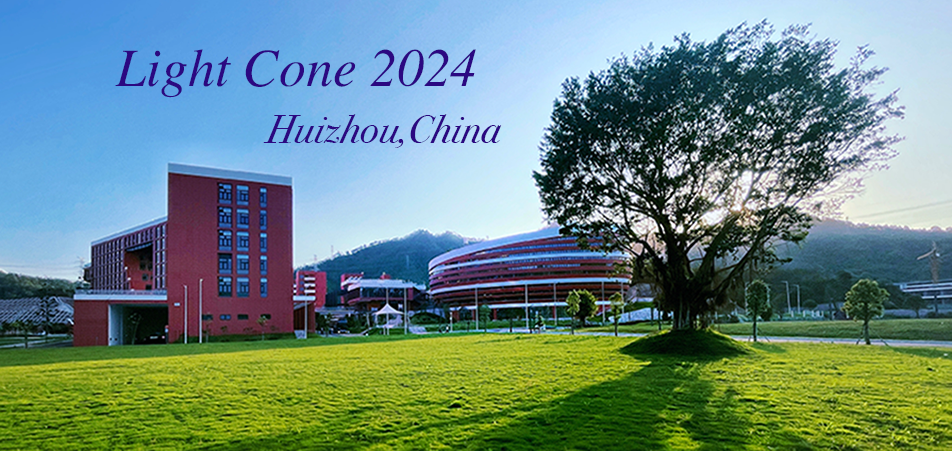Deeply Virtual Compton Scattering (DVCS) is the easiest reaction that accesses the Generalized Parton Distributions (GPDs) of the nucleon. GPDs offer the exciting possibility of mapping the 3-D internal structure of protons and neutrons by providing a transverse image of the constituents as a function of their longitudinal momentum. A vigorous experimental program is currently pursued at...
Transverse-Momentum dependent Distributions (TMDs) are a key tool to understand the internal partonic 3D structure of hadrons in momentum space. I will discuss some recent TMD extractions for quarks in the Nucleon, whose analyses are reaching a theoretical precision comparable to collinear Parton Distribution Functions (PDFs), and I will show the potential impact of future electron-ion...
Masses and spins of hadrons are fundamental quantities in physics; however, their origins are not understood yet and their investigations are major purposes of building electron-ion colliders in 2030's. Both of them can be investigated by generalized parton distributions (GPDs). The $t$-channel or spacelike ($s$-channel or timelike) GPDs are studied by deeply virtual Compton scattering...
We propose to detect signals from quark orbital angular momentum (OAM) through exclusive π production in electron-(longitudinally-polarized) proton collisions. Our analysis demonstrates that the sin 2ϕ azimuthal angular correlation between the transverse momentum of the scattered electron and the recoil proton serves as a sensitive probe of quark OAM. Additionally, we present a numerical...
The canonical Hamiltonian of QCD in the front form involves severe small-$x$ divergences that impede access to the logarithmically scale-dependent Hamiltonians for quarks and gluons. We propose a method for circumventing these divergences, thus opening a pathway for the systematic computation of the Hamiltonians using the renormalization group procedure for effective particles (RGPEP). Our...
Light-front (LF) wave function of a three-fermion system, forming a bound state with the total angular momentum $J=\frac{1}{2}$, is determined, in general, by 16 invariant components - in coincidence with number of combinations $2\times 2\times2\times2=16$, which spin projections of three constituents and their bound state are forming. Parity conservation, in contrast to a two-fermion system,...
The BESIII experiment locates at the BEPCII e^+ e^- collider in Beijing, China, running in a center-of-mass energy range from 1.8 GeV to 4.95 GeV. After 16 years of successful running of the experiment since 2009, BESIII has accumulated a large statistics of electron-positron annihilation sample, such as data set at J/ψ, ψ(2S) and ψ(3770) peaks, and fine scan data between 1.8 GeV and 4.95 GeV....
I will present a mass gap solution of the 1+1D QCD in the large Nc limit known as the ‘tHooft model to discuss a link between QCD and the Light-Front Quark Model (LFQM). I will illuminate the interpolation between the instant form dynamics and the light-front dynamics and discuss its utility in the computation of the parton distribution function (PDF). I will then illustrate the...
We introduce and explore a new type of $k_\perp$-dependent functions. The existence of this kind of TMDs has been stemmed from the factorization theorem and they are initiated by the interactions encoded in the corresponding correlators. In contrast to the well-known transverse momentum dependentfunction, the new functions can be associated with the collective alignment of quark spin vectors....
Light-front quantum mechanics is an alternative to light-front quantum
field theory for modeling strongly interacting systems at relativistic
energies. The advantages are that (1) rotational covariance is exact,
so there are no problems identifying states of a given spin or
applying arbitrary Poincar\'e transformations to these states (2) it
is possible to construct realistic models of...
We introduce the concept of the nucleon energy correlators, a set of novel objects that encode the microscopic details of a nucleon, such as the parton angular distribution in a nucleon, the collinear splitting to all orders, as well as the internal transverse dynamics of the nucleon.
I will review the application of few-body methods to explore the structure of light hadrons in Minkowski space. The description of the nucleon and pion are based on the solution of the Bethe-Salpeter equation in Minkowski space built with phenomenological kernels. For the proton, we will show results obtained with the projection onto the light-front of the Faddeev-Bethe-Salpeter equation,...
We report a lattice QCD calculation of the parton distribution function (PDF) of a deuteron-like dibaryon system using large-momentum effective theory. The calculation is done on three Wilson Clover ensembles with a fixed lattice spacing a=0.105 fm and two pion masses. The lattice matrix elements are computed at proton momenta up to 2.46 GeV with the signal of high momentum modes being...
I will briefly outline the current Stony Brook program to address the light mesons and hadrons on the light front, based on the current evidence of the topological nature of the QCD vacuum from lattice simulations. I will provide a detailed description of the light mesons: pions, kaons, rhos on the light front, using the instanton liquid model (ILM) of the QCD vacuum.
The energy momentum tensor (EMT) matrix elements appear in the moments of various parton distributions. The external gravity coupling to EMT provide the constraints to hadron structure due to equivalence principle, This provides the complementary aspect of Ji's sum rules and the possibility of its tests in the experiments with precise measurements of spin precession.
The notion of...

